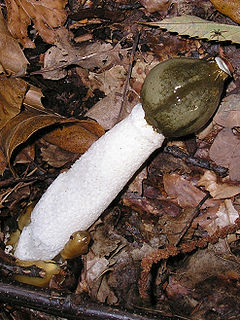Phallus (fungus)
| Stinkhorn | |
|---|---|
 |
|
| Common stinkhorn, Phallus impudicus | |
| Scientific classification | |
| Kingdom: | Fungi |
| Division: | Basidiomycota |
| Class: | Agaricomycetes |
| Order: | Phallales |
| Family: | Phallaceae |
| Genus: |
Phallus Junius ex Linnaeus, 1758) |
| Type species | |
|
Phallus impudicus L. |
|
| Species | |
|
18, see text. |
|
| Synonyms | |
|
Dictyophora sect. Clautriavia Pat. 1896 |
|
18, see text.
Dictyophora sect. Clautriavia Pat. 1896
Clautriavia (Pat.) Lloyd 1909
Cryptophallus Peck 1897
Dictyopeplos Kuhl & Hasselt 1824
Dictyophallus Corda 1842
Dictyophora Desv. 1809
Hymenophallus Nees 1817
Jaczewskia Mattir. 1912
Junia Dumort. 1822
Kirchbaumia Schulzer 1866
Leiophallus (Fr.) Nees 1858
Morellus Eaton 1818
Omphalophallus Kalchbr. 1883
Phalloidastrum Battarra 1755
Retigerus Raddi 1829
Satyrus Bosc 1811
Sophronia Pers. 1827
The genus Phallus, commonly known as stinkhorns, are a group of basidiomycetes which produce a phallic, often foul-scented, mushroom, from which their name is derived. The genus has a widespread distribution and, according to a 2008 estimate, contains 18 species. They belong to the family Phallaceae in the order Phallales. The best known species (and type species) is the common stinkhorn (Phallus impudicus).
The genus was first mentioned in the literature by the Dutch botanist Hadrianus Junius (1511–1575), who, in 1564 wrote a short book published in Delft on the Phallus in Hollandia, describing a mushroom in the form of a penis. He was not convinced that the organism was fungal in nature:
... I am not sure that our Phallus falls within the class of the fungi. I will not definitely decide to place it there because I do not want to make a judgment before others who know more about the matter. The lightness, however, and looseness of the substance and (a necessary condition for the existence of sponges) the sour sap of the moist earth where it was born, all bear witness that it belongs to the family of the fungi. However, the folds and creases, which do not exist here, but do among fungi, bear witness against it. There is also no trace of the cap that is normally connected to the stalk. Here the hat takes the place of the cap, and it can be removed without damage. Moreover, the site where it lives also argues against it, because this plant can only be found in dunes, and only there where old marram grass grows. Fungi, on the other hand, as stated clearly by authors, live in swampy, dirty, and rotting moist places, such as close to the roots of oak trees.
...
Wikipedia
